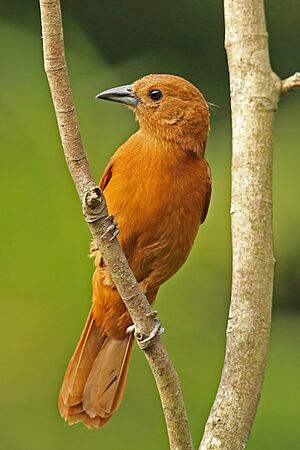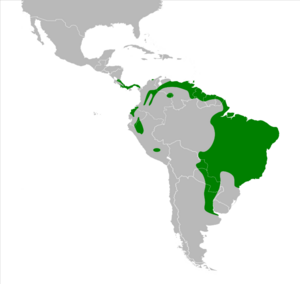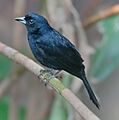White-lined tanager facts for kids
Quick facts for kids White-lined tanager |
|
|---|---|
 |
|
| male, Colombia | |
 |
|
| female, Trinidad | |
| Conservation status | |
| Scientific classification | |
| Genus: |
Tachyphonus
|
| Species: |
rufus
|
 |
|
| Synonyms | |
|
Tangara rufa (protonym) |
|
The white-lined tanager (Tachyphonus rufus) is a medium-sized bird. It belongs to the tanager family, called Thraupidae. These birds live in many places. You can find them from Costa Rica all the way south to northern Argentina. They also live on the islands of Trinidad and Tobago.
Contents
About the White-lined Tanager's Name
Scientists give every animal a special name. This helps everyone know exactly which animal they are talking about. The white-lined tanager got its first scientific name in 1783. A Dutch scientist named Pieter Boddaert gave it the name Tangara rufa.
Later, in 1816, a French bird expert, Louis Pierre Vieillot, put this bird into a new group, or genus, called Tachyphonus. The word Tachyphonus comes from ancient Greek. It means "fast speaker." The second part of its scientific name, rufus, is Latin for "red" or "ruddy." This describes the color of the female bird.
What Does the White-lined Tanager Look Like?
An adult white-lined tanager is about 18.5 centimeters (7.3 inches) long. It weighs around 33 grams (1.2 ounces). This bird has a long tail. Its beak is mostly black, strong, and pointed.
Male and female white-lined tanagers look very different. The adult male is shiny black. It has white feathers under its wings. There is also a small white patch on its upper wing. You can easily see these white parts when the bird flies. Otherwise, they are usually hidden.
Female and young white-lined tanagers are a reddish-brown color all over. They are a bit lighter on their undersides.
Where Do White-lined Tanagers Live?
These birds live in many parts of Central and South America. They like places that are partly open. This includes gardens and other areas where there are trees but also open spaces.
White-lined Tanager Behavior and Life
Reproduction and Nesting Habits
When it's time to find a mate, the male white-lined tanager puts on a show. He opens and closes the white spots under his wings. He does this in front of the female.
The female builds a large, cup-shaped nest. She places it in a tree or a bush. She usually lays three eggs, but sometimes two. The eggs are cream-colored with brown spots. The female sits on the eggs for about 14 to 15 days. These birds often have two groups of babies each year.
White-lined tanagers seem to like their own space. You usually only see one pair nesting in an area. They also don't often join other types of birds when looking for food. The song of the white-lined tanager is a quick, repeated "cheeru."
What Do White-lined Tanagers Eat?
These birds are always moving. They are not very shy. They eat many different kinds of fruit. They especially like fruits from plants that grow on other plants, called epiphytes. They also drink some nectar from flowers. In addition, they eat insects like beetles, ants, and grasshoppers.
In Trinidad and Tobago, people have special names for these birds. The male is sometimes called 'Parson'. The female is called 'Singing Angel'. People on these islands really like the white-lined tanager because of its beautiful whistling sounds.
Gallery





